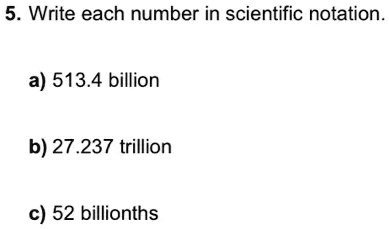Write each number in scientific notation. a) 513.4 billion b) 27.237 trillion c) 52 billionths

The Correct Answer and Explanation is:
a) 513.4 billion = 5.134 × 10¹¹ b) 27.237 trillion = 2.7237 × 10¹³ c) 52 billionths = 5.2 × 10⁻⁸
Now here’s your explanation:
Scientific notation is a standardized method of expressing numbers that are exceptionally large or incredibly small. It takes the form a × 10ⁿ, where a is a number equal to or greater than 1 but less than 10, and n is an integer that shows how many places the decimal point has been moved.
Let’s start with part (a). The term “billion” in the short scale system is equal to 10⁹. Therefore, 513.4 billion is 513.4 × 10⁹. To put this in scientific notation, shift the decimal point two places to the left, giving 5.134. Since you moved the decimal two places, you increase the exponent by 2, resulting in 5.134 × 10¹¹.
In part (b), 27.237 trillion is equivalent to 27.237 × 10¹², since a trillion is 10¹². To rewrite 27.237 in proper scientific form, shift the decimal one place to the left to get 2.7237. To balance that, increase the exponent by 1, leading to 2.7237 × 10¹³.
Finally, part (c) deals with a very small number. “Billionths” means parts per billion, or 10⁻⁹. So 52 billionths becomes 52 × 10⁻⁹. Adjust 52 to 5.2, which moves the decimal one place to the left. Compensate by increasing the exponent negatively, yielding 5.2 × 10⁻⁸.
Scientific notation simplifies comparisons and calculations involving extreme values. It makes data more manageable, especially in fields like physics, chemistry, astronomy, and engineering.
